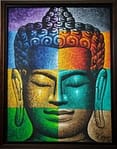“Birth is suffering, aging is suffering, sickness is suffering, death is suffering. Sorrow, lamentation, pain, grief, and despair are suffering. Association with the loathed is suffering, dissociation from the loved is suffering, not getting what one wants is suffering; in brief, the five aggregates subject to clinging are suffering.”
Understanding the Four Noble Truths
The Four Noble Truths constitute the fundamental doctrine of the Buddha’s teachings:
- The Noble Truth of Suffering (Dukkha):
- Suffering exists in various forms: birth, aging, sickness, and death.
- Sorrow, lamentation, pain, grief, and despair also constitute suffering.
- The five aggregates subject to clinging are ultimately a source of suffering.
- The Noble Truth of the Origin of Suffering (Samudaya):
- The root of suffering is craving (tanha) for sensual pleasures, existence, and extermination.
- This craving leads to renewed existence, attachment, and the cycle of suffering.
- The Noble Truth of the Cessation of Suffering (Nirodha):
- The cessation of suffering is achieved by relinquishing and abandoning craving.
- It is the complete fading away and cessation of desire, leading to non-attachment and liberation.
- The Noble Truth of the Path Leading to the Cessation of Suffering (Magga):
- The path to liberation is the Noble Eightfold Path:
- Right View
- Right Intention
- Right Speech
- Right Action
- Right Livelihood
- Right Effort
- Right Mindfulness
- Right Concentration
- The path to liberation is the Noble Eightfold Path:
The Five Aggregates Subject to Clinging
The First Noble Truth identifies the five aggregates as fundamental to suffering:
- Form (Rupa) – The physical body and material aspects.
- Feeling (Vedana) – Sensations of pleasure, pain, or neutrality.
- Perception (Sanna) – Recognition and mental labeling of experiences.
- Mental Formations (Sankhara) – Volitional activities, thoughts, and habits.
- Consciousness (Vinnana) – Awareness of sensory and mental experiences.
These aggregates are impermanent, non-self, and subject to change. Understanding this leads to dispassion and liberation from attachment.
Cultivating Insight
To fully comprehend the Four Noble Truths:
- The truth of suffering must be fully understood.
- The origin of suffering must be abandoned.
- The cessation of suffering must be realized.
- The path leading to the cessation of suffering must be developed.
By walking the Noble Eightfold Path, one progresses toward the cessation of suffering, ultimately attaining Nibbana—the highest liberation.
♥ ♥ ♥ ♥
Please click on the following links to read previously published posts “Meditate Like The Buddha: A Step-By-Step Guide” 👉
☆ Meditate Like The Buddha #1: A Step-By-Step Guide ☆ Mr. Jagat Singh Bisht ☆
☆ Meditate Like The Buddha #2: The First Step ☆ Mr. Jagat Singh Bisht ☆
☆ Meditate Like The Buddha #3: Watch Your Breath ☆ Mr. Jagat Singh Bisht ☆
☆ Meditate Like The Buddha #4: Relax Your Body ☆ Mr. Jagat Singh Bisht ☆
☆ Meditate Like The Buddha #5: Cultivate Loving kindness ☆ Mr. Jagat Singh Bisht ☆
☆ Meditate Like The Buddha # 6: Experience your feelings ☆ Mr. Jagat Singh Bisht ☆
☆ Meditate Like The Buddha # 7: Tranquilize Mental Formations☆ Mr. Jagat Singh Bisht ☆
English Literature – Articles ☆ Meditate Like The Buddha # 8: Midway Recap ☆ Mr. Jagat Singh Bisht ☆
© Jagat Singh Bisht
Laughter Yoga Master Trainer
FounderLifeSkills
A Pathway to Authentic Happiness, Well-Being & A Fulfilling Life! We teach skills to lead a healthy, happy and meaningful life.
The Science of Happiness (Positive Psychology), Meditation, Yoga, Spirituality and Laughter Yoga. We conduct talks, seminars, workshops, retreats and training.
≈ Editor – Shri Hemant Bawankar/Editor (English) – Captain Pravin Raghuvanshi, NM





